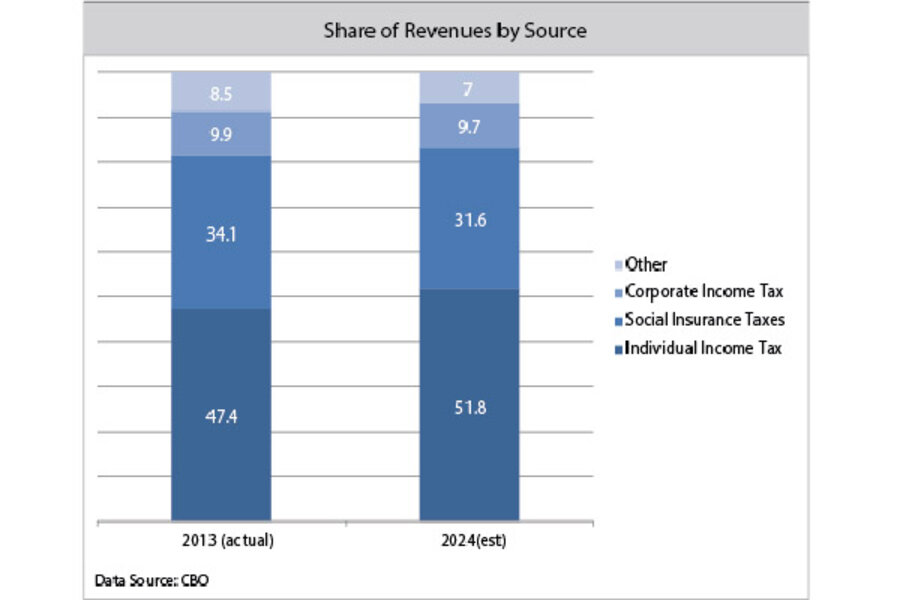CBO: Individual income tax will fund half of federal revenue
Loading...
Over the next decade, the individual income tax will be the fastest growing source of federal revenue, according to new estimates by the Congressional Budget Office. In fact, the individual income tax will pretty much be the only revenue source likely to increase significantly over the next decade. As a result, it will generate more than half of all federal revenue for the first time since the turn of the 21st century.
Overall, CBO figures total federal revenues will grow from their recent recession-battered low of 14.6 percent of Gross Domestic Product in 2009 and 2010 to about 18.4 percent in 2024. CBO projects revenues this year will rebound to 17.5 percent of GDP. Over the decade, revenues will average about 18.1 of GDP, which is pretty close to the historic post-WW II average.
But the really interesting story is in the composition of revenues. Nearly all the projected increase in taxes will come from the individual income tax: CBO projects the levy will rise from 8.0 percent of GDP this year to 9.4 percent by 2024.
As a result, CBO figures that a decade from now, the individual income tax will account for nearly 52 percent of all federal revenue. The last (and only) time the individual tax generated half of all federal revenues was in 2001, just before the dot.com bubble burst and Congress passed the first of the huge George W. Bush-era tax cuts.
Moreover, the federal government has rarely collected as much as 9.4 percent of the total economy in individual income tax. According to the Office of Management & Budget, this happened only in 1944, 1981 (just before President Reagan’s tax cuts), and during the stock market boom in 1998-2001.
While individual taxes are expected to increase, other major sources of revenue will barely change as a share of the economy. For instance, the payroll taxes that fund Social Security and Medicare will remain flat through the next decade, CBO figures. They represented 5.7 percent of GDP last year, 6.0 percent this year, and are projected to fall to 5.8 percent in 2016 and stay at that level.
The corporate income tax will rise as a share of GDP for the next few years and then drift down. On average it will hover at about 2.0 of GDP for the next decade. And it will average only about 11 percent of all federal revenue through the period. That’s a significant increase from the depths of the recession when corporate taxes collapsed to barely 6 percent of total revenues. But it is a far smaller share than in the 1960s, when it averaged one-fifth.
What will drive these changes? It is the proverbial long story. But CBO identifies a few culprits.
CBO explains much of the rise in individual income taxes by expected increases in real incomes produced by a recovering economy, including higher wages, salaries, capital gains, and income to owners of pass-through firms, who report their taxes on their individual returns. CBO also expects a significant increase in distributions from retirement accounts for at least the next few years, driven in part by higher asset values.
Two other reasons: Higher tax rates for upper-income households (including the surtax in the Affordable Care Act) and the phenomenon known as real bracket creep. Tax brackets are adjusted for inflation but not economic growth. For at least the next few years, CBO figures incomes will grow faster than those inflation-adjusted brackets.
On the corporate side, CBO projects a bump in tax revenues through 2017, but a fall-off after that. A key reason is that CBO assumes that dozens of business tax breaks (the so-called extenders) will disappear (they technically expired at the end of 2013). If they are extended, as is likely, corporate tax revenues are likely to fall below CBO’s forecast.
I suspect these projections will be something of a Rorschach test for lawmakers. Anti-tax conservatives will see them as a reason to cut individual taxes. Progressives will use them to oppose cuts in corporate tax rates and justify increases in the Social Security payroll tax cap. But whatever you want to read into them, these projections are pretty interesting.







